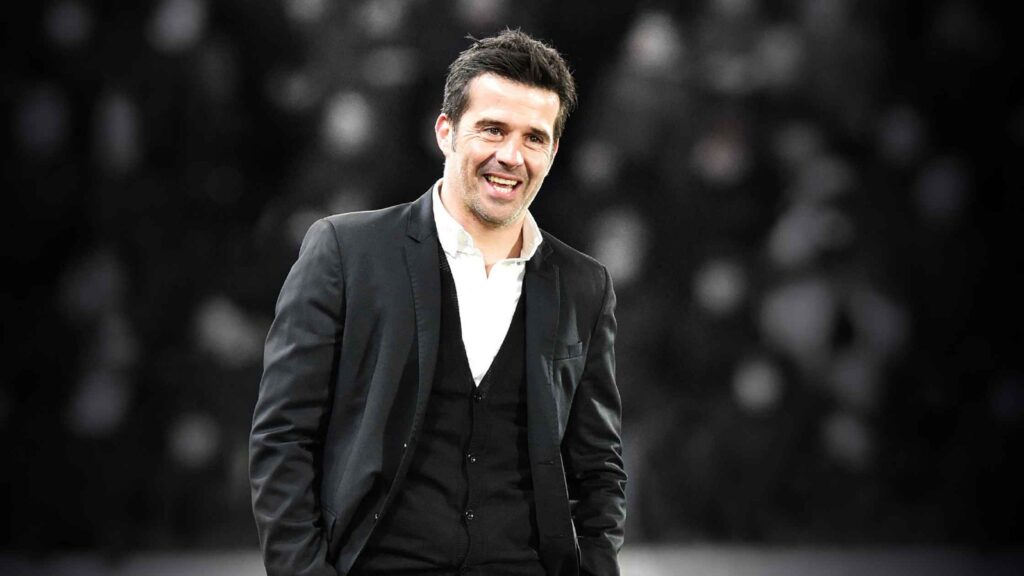Marco Silva is the latest manager to get the media spotlights aimed at him after helping a minnow club reach Premier League success. But this is hardly a fluke, and Fulham’s continued progress can serve as inspiration for all clubs of its stature.
At the heart of this well-executed job are Marco Silva’s tactics, progressive ideas and the club’s sound planning. Here’s a closer look at those.
Career Prior to Managing Fulham
Marco Silva enjoyed a relatively lengthy career as a footballer. For the most part he played as a right-back for lower-tier clubs in the Portuguese football pyramid.
He began his coaching career in 2011, taking on the job of manager of Estoril, the team for whom he’d played during the previous six years. He helped the team promote to top division and lead it as far as fourth place.
This led to being offered a job with Sporting Lisbon, one of Portugal’s most important teams. Poor results influenced the board’s decision to sack him.
After this, Silva managed briefly in Greece before being tasked with saving Hull City from Premier League relegation. While he did not succeed in this objective, the Portuguese manager impressed enough to receive subsequent employment opportunities from Watford, Everton and, in 2021, Fulham.
Silva managed to get Fulham promoted back into the Premier League on his first try. The team’s finished, above expectations, mid-table across its last three campaigns in the top division.
Tactical Philosophy
Marco Silva, for the most part, is a manager who encourages positive, attacking football. This is unexpected. Remember that Silva helped Fulham get promoted in 2021. And also consider the fact that most teams of Fulham’s stature tend to play route one passes and sit back.
On the other hand, Silva wants Fulham’s players to control possession whenever possible. However, quick counter-attack drills are clearly worked through in training. And the team is known to carefully and patiently maintain its defensive shape.
In some ways, Marco Silva is one of the many, many managers who has tried to act like Pep Guardiola, and one of the few who has generally succeeded.
Formations and Adaptability
Fulham’s recorded a number of victories against high-profile teams this season. Chelsea, Liverpool and Manchester United have all been beaten by Marco Silva’s tactics at some point this season. The formations and the team’s ability to adapt has been key.
Nominally, Silva likes to line Fulham up in a flexible 4-2-3-1. That in itself is nothing eccentric. This, in turn, is an evolution from the fluid 4-3-3 style used across last season.
However, to understand Silva, one needs to look at how his players approach their roles in and out of possession.
For example, when in defence, one of the wingers will drop back to create, essentially, a 5-3-2. Or, when in attack, wide players will rotate and use the influence of central midfielders or attackers who’ll track back to try and create passing triangles.
Fulham in Defence
At the time of writing, Fulham sits in 11th place, still dreaming of European football. They’re also the 11th-best team in terms of goals conceded. Coincidence?
No, this is a relevant stat. Fulham’s outscored some of the teams ahead of it in the table. Meanwhile, the soon-to-be relegated teams have conceded more than 70 goals compared to the Cottagers’ present 51.
Marco Silva uses a four-man defence line. Pressing is encouraged, but under a controlled approach. The team tends to defend in a mid or high block.
When defending, it’s not uncommon for one of the wingers to drop down and play in the middle. Or, more recently, with the full-back sitting back and providing width, the two defensive midfielders, Berge and Lukic, have tended to slide between and just ahead of the two central defenders.
One of Fulham’s greatest assets this season has been its sturdy defensive organisation. The fluid approach and tactical understanding help defenders stop attacks between the lines.
Silva’s game instructions typically help the defenders to squeeze out space, block passing lanes and stop crosses.
Fulham in Transition
Fulham’s 20254/25 tactical approach has not been rooted to a single way of progressing the ball. Silva’s knowledge, and the fact that he’s been serving as team manager for a while, means that players have been well-drilled in how to adapt to the opposition.
Typically, the team will look to play out from the back. Calvin Bassey, in particular, is comfortable with the ball at his feet. The defender will generally try to play vertically or make a run past the pressing attacker.
Meanwhile, Fulham’s corresponding full-back and defensive midfielder adapt in order to give the defender options to play the pass. It’s an approach that’s occasionally proven risky.
Marco Silva likes to encourage role rotations. This helps confuse markers when Fuham’s building up. Adama Traore and Alex Iwobi are, technically, wingers/inside forwards. But both have experience as full-backs. They’ll, in fact, often switch positions with the full-backs during games.
The central midfielders, Andreas Pereira and Sander Berge, will also drift into wide areas when this is required. It’s a nicely drilled approach that’s often helped Fulham.
Still, Fulham plays against plenty of tough opposition against which these short passes might not work. In this case, Silva wants his team to take advantage of quick turnovers and play quick, vertical passes up top.
But just what do attackers do with their opportunities?
Fulham in Attack
While Raul Jimenez’s recovery from injury and return to form has been on eo ftrhe stories of this season, Fulham’s often been undone by the team’s inability to make good on great xG chances.
In theory, Fulham plays one striker, a classic poacher up top. That player’s usually Jimenez, deputised by Rodrigo Muniz. Also, to simplify, the team likes to build up through rotations on the flank before looking for a pass through the middle.
But this is where Silva shines in giving his team several avenues to score. Typically, the team attacks through quick turnovers, where the quick-attacking midfielders also make runs through the middle. This is designed to overwhelm the opposition’s defenders and provide crossing options.
It’s also not uncommon for Fulham to play in almost 4-2-4 shape, where two players look to create overloads in wider areas. Alternatively, two strikers may be deployed centrally, with two of the midfielders playing just behind them.
Still, Fulham might’ve scored more goals this season. The team now averages 4.36 shots on goal per 90 minutes, a stat that, again, places them square in the middle of the table. Meanwhile, Fulham has a combined xG of 46.8 with 50 goals scored. It should be noted that the team’s good run of results during February and March contributed to improving this statistic.
What’s Next for Fulham and Silva?
Fulham has been one of the better teams in the Premier League this season. If they fail to qualify for each European qualification, it will be because of the atypical positive results of similar-calibre clubs like Nottingham Forest, Brentford, or Aston Villa.
Clearly, though, Silva’s done a good job. At the moment, and for a while still, Fulham is a team that can put up a fight against any opposition.
Still, frankly, analysing the season’s current stats, Fulham is fairly placed in the middle of the table. Its goals tally now reflects its xG, and the goals conceded also make it an average participant in the EPL. The team’s squad has been well-recruited, but there isn’t terrific depth on which to depend. And, there’s no reason why its stars or manager should depart the club soon.
But Fulham’s good fortune may be the motivation Marco Silva needs to change jobs. It was recently reported that he was offered a big-money move to Saudi Arabia. Other EPL clubs may also come calling.
While it’s tempting to consider such options, at the end of the day, Fulham and Silva’s position may be the very best that either could’ve acquired at this time. Why spoil this?


















